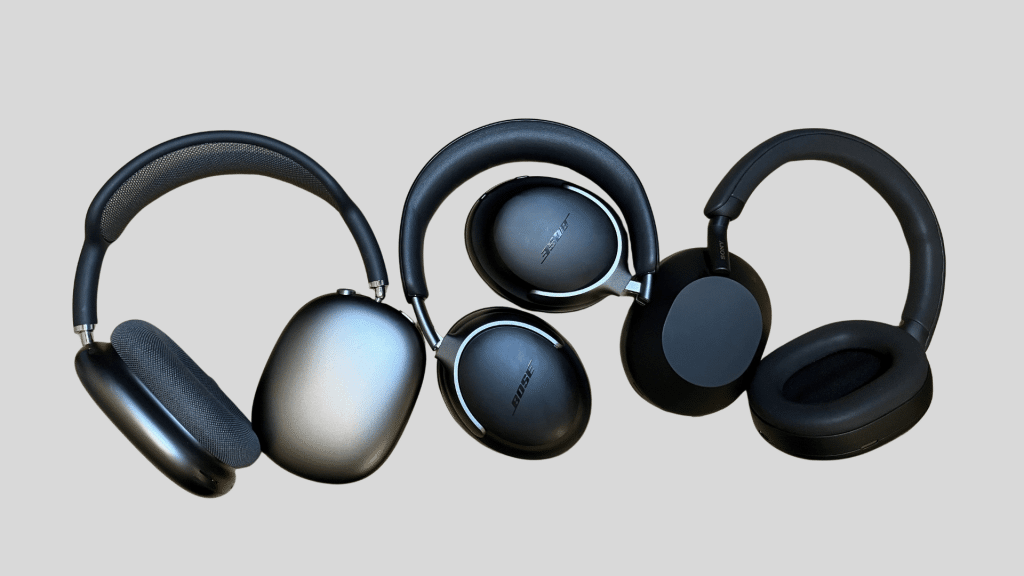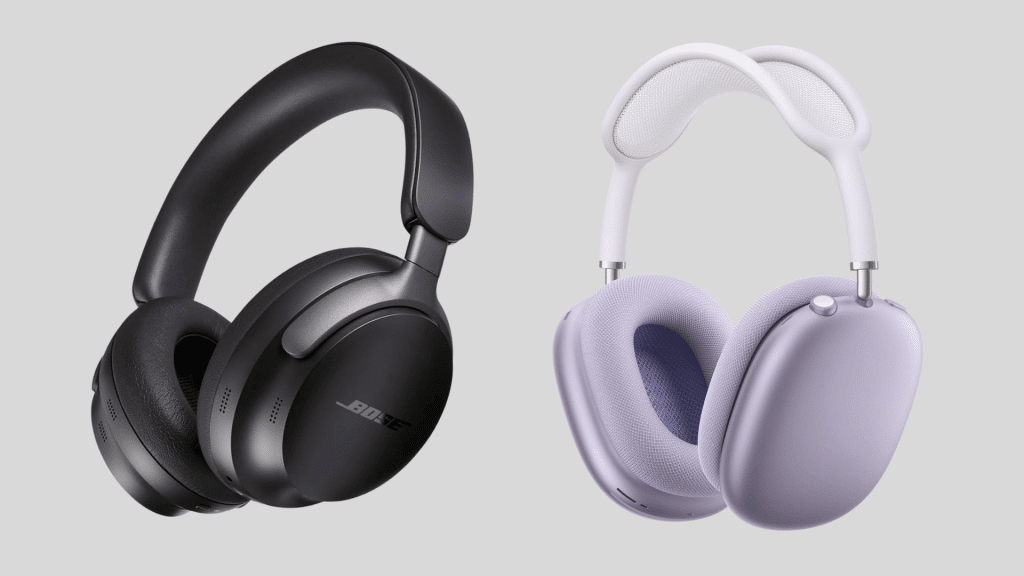Choosing between Bose vs Apple headphones can feel like a tough call. Both brands make excellent products known for great sound, sleek design, and reliable performance, but they focus on different priorities.
Bose is known for its unbeatable noise cancellation, all-day comfort, and long battery life, making it ideal for travelers and everyday listeners.
Apple, on the other hand, focuses on seamless connectivity, Spatial Audio, and smart features that work best within the Apple ecosystem.
This comparison breaks down how both perform in real life, from sound and comfort to features and long-term value. By the end, you’ll have a clear idea of which pair truly matches your listening style and daily routine.
Bose and Apple: What Each Brand Offers
Both brands deliver high-end sound and active noise cancellation, but their design goals differ:
- Bose aims for relaxed, balanced sound with comfort and practicality in mind. It’s known for soft ear cushions, a lightweight build, and consistent ANC performance.
- Apple focuses on sound precision, spatial depth, and deep integration within the Apple ecosystem. AirPods Max and Pro models feel premium and work best with iPhones, iPads, and Macs.
If you want easy pairing, immersive sound, and Apple-only features, go with AirPods. For comfort, value, and all-day use, Bose makes more sense.
Features, Performance, and Battery

Bose and Apple bring strong features, reliable performance, and solid battery life. Yet, they approach these aspects differently based on user needs and ecosystems.
1. Sound Quality
Bose offers a clean, balanced sound that works for any genre without harsh highs or boosted bass. The tuning feels natural, making long listening sessions easy.
Apple takes a different approach with Spatial Audio and Adaptive EQ, creating a fuller, more detailed sound. It feels more immersive but also slightly warmer, ideal for users who prefer rich, layered playback.
2. Noise Cancellation
Bose leads in active noise cancellation. It reduces low, constant sounds like engine noise and air conditioning better than most brands.
Apple’s adaptive ANC is smart and effective for sudden noises, but doesn’t block steady sounds as strongly. Bose’s approach is smoother and more consistent, making it a better fit for flights, commutes, and open office use.
3. Comfort and Design
Bose is lightweight with soft ear pads and less clamping pressure, making it comfortable for all-day wear. Apple’s aluminum and steel frame feels premium but heavier, which can cause fatigue over time.
Bose’s materials feel simpler but practical for travel. Apple’s build looks sleek and modern, appealing to users who value design over long-term comfort.
4. Connectivity and Ecosystem
Apple headphones pair instantly with iPhones, iPads, and Macs using iCloud. Auto-switching between devices is seamless, and Find My adds extra convenience.
Bose offers broader compatibility with Android, iOS, and Windows through Bluetooth multipoint pairing. It supports aptX Adaptive for higher-quality streaming, giving Android users smoother and clearer sound.
Each brand wins in its own environment.
5. App Experience and Customization
Bose and Apple take different approaches to software design.
The Bose Music App gives users control over EQ settings, noise cancellation levels, and Bluetooth connections, perfect for those who like customizing their audio.
Apple, on the other hand, integrates audio controls directly into iOS and macOS.
Adaptive Audio and Personalized Spatial Audio automatically adjust to your surroundings and ear shape, focusing on convenience and automation rather than manual control.
6. Call Quality and Microphone Performance
For calls and meetings, each brand performs well but in different ways. BoseQuietComfort Ultra uses beamforming microphones that cut background noise and wind, keeping voices clear in busy or outdoor areas.
Apple’s AirPods Max and Pro 3 use mic arrays with computational audio for sharp indoor clarity, though Bose handles outdoor conditions more consistently.
7. Battery and Charging
Bose headphones last up to 24 hours, while the earbuds give around six hours plus extra from the case. A 15-minute charge adds 2.5 hours of playback.
Apple offers about 20 hours on AirPods Max and six on AirPods Pro 3. Newer models use USB-C, and a 5-minute charge adds roughly one hour. Bose lasts longer; Apple charges faster.
8. Durability and Portability
Bose headphones are built for travel, using lightweight plastics that resist flexing and reduce fatigue during long sessions. The compact carrying case folds neatly into backpacks or suitcases.
Apple’s design uses aluminum and stainless steel, giving a premium feel but adding weight. While they look impressive, they can scratch more easily, and the AirPods Max Smart Case offers less protection for frequent travelers.
Price, Value, and Warranty
Price and long-term value matter as much as performance. Both brands sit in the premium range but differ in what you get for the cost.
- Bose headphones usually cost around $429–$449, depending on the model.
- Apple’s AirPods Max and Pro 3 range from $499–$549.
Bose gives better value for price, especially for users who don’t need Apple’s ecosystem features.
For repairs, Bose parts and service are generally cheaper and easier to arrange. AppleCare+ extends coverage for AirPods but adds to the total cost. Repairs outside warranty are expensive, especially for AirPods Max.
Bose offers solid build quality, lower repair costs, and good customer support. Apple gives premium materials and longer ecosystem value, but at a higher price.
Best Choice by Use Case

Choosing between Bose and AirPods comes down to your priorities – whether you value cross-platform versatility or deep Apple ecosystem integration.
Who Should Choose Bose
- Cross-Platform Users: Works seamlessly with Android, Windows, and iOS devices.
- Frequent Travelers: Superior noise cancellation and comfort for long journeys.
- Battery Life Seekers: Longer playback time and quick recharging options.
- Sound Customizers: Adjustable EQ through the Bose Music app for tailored audio.
Who Should Choose AirPods
- Apple Ecosystem Users: Perfect for those using iPhone, iPad, and Mac.
- Seamless Integration Fans: Instant pairing, automatic switching, and spatial audio support.
- Minimalist Listeners: Lightweight, intuitive, and ideal for everyday convenience.
- Voice Assistant Users: Deep Siri integration for effortless hands-free control.
Real-World Opinions
When it comes to real-world feedback, many users have shared mixed but insightful opinions about both Bose and AirPods, reflecting their strengths and small shortcomings in everyday use.
Bose:
“These are the best Bose earbuds I’ve ever owned — amazing comfort, sound, and noise cancelling.” — trellus, Head-Fi Forum
“Perfect for blocking out office noise and background chatter; exactly what I needed.” — 6baglowchert5slump, Reddit
“Sound quality is great, but the right earbud sometimes disconnects while walking.” — SoundGuys user, SoundGuys Forum
AirPods:
“My AirPods Pro 2 are my most-used headphones — great form factor and easy everyday use.” — scotchrocks, Audio Science Review Forum
“Didn’t like the sound profile much; probably returning them.” — Acrobatic-Monitor516, Reddit
“Used them on multiple flights — barely heard the plane noise, incredible ANC.” — angelom, Head-Fi Forum
Conclusion
The comparison between Bose and Apple headphones highlights how both brands continue to refine and influence modern audio technology in unique ways.
Bose focuses on user comfort, intelligent noise control, and balanced sound that suits extended use, while Apple leads with spatial precision, device intelligence, and software-driven sound experiences.
Both brands aim to deliver innovation that goes beyond hardware, combining style and technology for everyday convenience.
Ready to upgrade your listening experience? Check out the latest Bose and Apple headphones to find the perfect fit for your sound and lifestyle.








